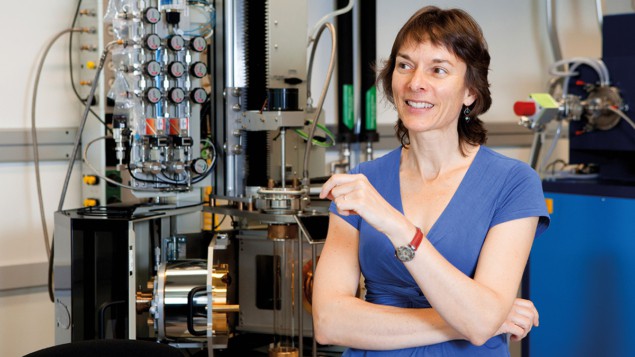2022 Europhysics Prize and Hamburg Prize for Theoretical Physics winner Nicola Spaldin talks to Laura Hiscott about her work on magnetoelectric multiferroics, the importance of finding fun in research and how physics can benefit from a more flexible idea of excellence

When Nicola Spaldin began studying natural sciences at the University of Cambridge in 1988, she planned on becoming a physicist, but then quickly reconsidered. “After about the second lecture I completely changed my mind,” she recalls. “I thought ‘I’m absolutely not clever enough to be a physicist.’ Everybody was very brilliant and I was not.”
Yet it seems Spaldin was vastly underestimating herself. Now a professor of materials science at ETH Zurich, she won two major awards for physics last year: the EPS Europhysics Prize and the Hamburg Prize for Theoretical Physics. Both accolades cited Spaldin’s pioneering work on the theory of magnetoelectric multiferroics – materials that are both ferromagnetic and ferroelectric. These properties are rarely found together, making it very difficult to engineer substances with both, but they have many exciting potential applications, from microelectronics to medicine.
At first glance, Spaldin’s path to materials science might appear circuitous. After focusing on chemistry and geology at Cambridge, she did a PhD in theoretical chemistry at the University of California, Berkeley – on the optical properties of nanoscale semiconductors – before working as a postdoc on ferromagnetism in the applied physics department at Yale University. But despite apparent changes in discipline, all her projects were to do with materials, which Spaldin points out lie at the intersection of chemistry, physics and engineering. “In that sense I haven’t really changed much,” she says. “I’ve just changed the department I’ve done it in.”
So, although fundamental physics is the basis for her research, she considers herself a materials scientist first and foremost. Her passion for this field shines through when she talks about how eras of human civilization – from the Stone Age onwards – have been defined by and named after the materials we have learned to wield. And she believes that discovering new materials is still the key to shaping our future. “Had I known about materials science at school, I probably would have studied it as an undergraduate,” she says.
Mixing materials
Ferromagnetic materials are substances that can form permanent magnets. Ferroelectric materials, in contrast, can form electric dipoles on a macroscopic scale when exposed to an applied electric field, retaining this polarization even after the field is removed. But when doing her postdoc on ferromagnets at Yale, Spaldin found herself working alongside people studying ferroelectrics and was struck by how different the two types of materials are. She therefore began to wonder if the two properties could co-exist as a “multiferroic” material. Spaldin discovered that both phenomena are the result of different electron configurations in the respective materials.
Ferromagnetic elements – such as iron, cobalt and nickel – have partially filled outermost electron shells and the spins of unpaired electrons contribute to an overall magnetic moment. On the other hand, ferroelectric materials tend to contain ions with empty outer electron shells, enabling strong chemical bonds with neighbouring atoms to create electric dipoles. “Materials that are good at making magnetic moments and materials that are good at being ferroelectric are in different places in the periodic table,” says Spaldin. “There’s no law or rule that they can’t do both, it’s just hard to find the combination of atoms that can.”
Applied curiosity
Having proved that there is no fundamental law of physics keeping ferromagnetism and ferroelectricity separate, Spaldin and her colleagues set about devising materials with both. It’s not easy though and there are two main ways of tackling this challenge. One is to design materials that contain both types of atom. These often have a crystal structure containing magnetic atoms, oxygen and positive metal ions found in ferroelectric materials.
Another approach is to embed magnetic atoms within lattices whose shapes are amenable to creating dipoles. For example, the unusual layered structure of yttrium manganite allows electric dipoles to form from the relative displacements of the yttrium and manganite substructures, despite the presence of the magnetic manganese ions.
Spaldin enjoys the challenge, but that isn’t the only reason this is such exciting research. “They’re hard to make so it’s fun to engineer them,” she says, “but then when you have them it means you can control or tune the magnetic properties using an electric field.”
One potentially transformative application would be in microelectronic technologies, where magnetism is used for data storage. The magnetic properties of components currently have to be controlled with magnetic fields, but these require significantly more energy to generate than electric fields. A material whose magnetic properties could be coordinated instead with an electric field could mean much cheaper and more sustainable electronics.

Meanwhile, the reverse capability – of controlling a material’s electrical polarization with a magnetic field – is of great interest in medicine. For instance, researchers are already working on targeted drug-delivery techniques, whereby an external magnetic field guides multiferroic particles through the body, and then changes their electric polarization to release the drug where it is needed.
These innovations notwithstanding, Spaldin is keen to emphasize the importance of purely blue-skies research, which is what originally led her down this path. “When we started playing with multiferroics there were no device physicists waiting for them,” she explains. “It wasn’t that they didn’t exist, it was that nobody had really thought of trying to combine the properties. So I think there has to be a bit of completely, absolutely curiosity-driven work – ‘just give this a try and see what happens’.”
Diverse perspectives
Reflecting on her career path to date, Spaldin speculates that she was initially put off physics thanks to the prevailing inflexible view of what a theoretical physicist should look like. “The way physics was taught, it wasn’t approached with what today we call a ‘growth mindset’ for learning,” she says, explaining that the attitude was that “you were there and you were brilliant or you should go and do something else instead”.
Spaldin takes a different approach with her own research group, aiming to have as diverse a team as possible, not only in terms of gender and background, but also in terms of people’s strengths and potential.
“I want to have a group that has many different perspectives and many different aspects of excellence,” she explains. “There’s still a rather narrow picture of what an excellent scientist is, even a young scientist who still really has time to develop, and that’s not always very diverse or different from the previous picture of what a scientist should be.”
This is also relevant to Spaldin’s science-policy work. She is currently a member of the European Research Council’s Scientific Council, which is required to distribute its allotted budget based only on excellence. “But how to assess excellence is of course an open question.” The council discusses and commissions studies on how to best evaluate the merit of a scientist or their proposals. Changes to evaluation criteria might also help to promote gender parity in the European scientific community, where women continue to be under-represented, particularly in physics.
Spaldin notes that under the traditional ways of assessing researchers, women were more likely to be in a situation where they would be poorly evaluated. For instance, if they had more responsibilities for looking after a family, they might have less freedom to migrate for work. The ERC has therefore removed the question of mobility on applicants’ CVs to try to level the playing field. “These developments would be good for everybody,” Spaldin adds, “but maybe particularly good for women.”
Finding what’s fun
Although Spaldin’s research was ignited by her fascination with multiferroics, her work could have a more far-reaching impact in physics. For example, she is now also looking at the possibility of engineering a room-temperature superconductor. Although it is unlikely that a multiferroic material would exhibit this property, progress could stem from the same underlying theoretical picture.
In another project, more cross-disciplinary still, Spaldin is working with astrophysicists to detect dark matter. There are many proposed theoretical descriptions of this enigmatic substance, and Spaldin is helping to predict how each hypothetical kind of dark-matter particle would interact with electrons within different materials.
I want to have a group that has many different perspectives and many different aspects of excellence
So far, this project has mostly involved whittling down the possible characteristics of dark matter by excluding models that would imply interactions that have not been observed in existing detectors. But Spaldin and her collaborators are also thinking about which materials might make for promising new detectors, depending on the remaining possible descriptions. “This for me is just so much fun because it’s so far from my comfort zone,” Spaldin says. “It’s almost a different language that we speak in the project, so I’m enjoying it very much.”
And this enthusiasm is what she returns to again and again. Of course, achieving a room-temperature superconductor or detecting dark matter would be revolutionary, whether in the infrastructure of our daily lives, or in our fundamental understanding of the cosmos. But even these profound prospects seem to be secondary factors in Spaldin’s motivation. “Mostly I really want to work on problems that are fun,” she says. “Life is short!”



